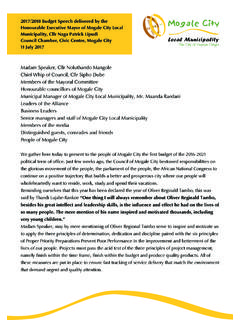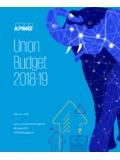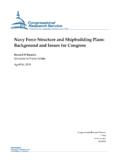Transcription of Defence prooff AA 12 Feb - National Treasury
1 465 Vote 21 Defence Amount to be appropriated R18 414 380 000 Statutory appropriations Responsible Minister Minister of Defence Administering Department Department of Defence Accounting Officer Secretary for Defence Aim The aim of the Department of Defence is to defend and protect South Africa, its territorial integrity, and its people, in accordance with the Constitution and international law regulating the use of force. Key objectives and programmes The objectives of the Department of Defence are: To defend South Africa, according to international law, against any aggression or threat of aggression that endangers its stability To deploy forces to enhance security internally or externally following government decisions To provide support to the population or government departments in operations other than war The Department s main functions are to provide and maintain Defence capabilities and to deliver services in terms of Defence commitments made by Government, both internally and externally, whenever members of the South African National Defence Force (SANDF) are utilised.
2 The Department collaborates with a range of government, regional, and international players to ensure that these objectives are met. There are nine budget programmes through which the Department pursues its objectives: Administration deals with the overall management of the Department. Landward Defence , Air Defence and Maritime Defence provide and maintain capabilities for defending and protecting the country. Military Health Support provides and maintains medical combat support, as well as medical services to members of the Department and their dependants. Defence Intelligence provides military intelligence and counter-intelligence capabilities. Joint Support provides generic supplies and services to various components of the Department. Command and Control provides and maintains an operational command and control capability for the deployment of combat forces, and maintains a Special Forces capability.
3 Special Defence Account provides for the acquisition of Defence equipment, including in the strategic arms procurement programme. Strategic overview and key policy developments: 1998/99 2004/05 Over the past year the SANDF provided a diverse range of services to South Africa and other African nations, including: operations to combat crime in cooperation with the South African Police Service (SAPS); patrolling the country s borders and rural areas; providing aid to other government departments (especially the departments of Health and Agriculture); and fulfilling international obligations during peace support operations in the Democratic Republic of the Congo (DRC), Burundi, and the Horn of Africa. 2002 Estimates of National Expenditure 466 The Defence Review, which followed the 1996 White Paper on National Defence , developed a Force Design for the SANDF.
4 The review, and the resulting structures of the Department, are being revisited in the light of projected medium-term resource constraints. A new Force Design and Force Structure will be presented early in 2002, and, if approved, will be implemented in 2004. It is envisaged that the Department s rightsizing process will continue beyond 2004/05. Although it is possible that some units may have to be closed, personnel will, as far as possible, be redeployed to other units. The SANDF has developed the training capacity to re-skill personnel who may be transferred to other government departments or who may become redundant. In the meantime, the Department has reprioritised activities, taking into account the maintenance of personnel, Defence capabilities and capacities, operational readiness, preparation for Defence contingencies, the execution of operational tasks, commitments, and contractual obligations.
5 After a decade of declining investment in South Africa s Defence capability, and in the light of the 1996 Defence Review, Government has embarked on a 12- year strategic arms procurement programme. It includes the purchase of 4 naval corvettes, 3 submarines, 30 light utility helicopters, 24 trainer aircraft and 28 fighter aircraft, at a total cost in 1999 prices of US$4,8 billion (R30,3 billion). The Defence Vote includes the full costs of these purchases, including provision for inflation-related price escalation and projected exchange rate movements. Currently, total cash outlays are projected to amount to R52,7 billion, with annual payments reaching a peak of R7,7 billion in 2005/06. projected annual commitments are summarised below: 2000/01 2001/02 2002/03 2003/04 2004/05 2005/06 R million 2 639 4 047 6 331 7 199 7 194 7 704 2006/07 2007/08 2008/09 2009/10 2010/11 2011/12 Total R million 5 960 4 491 3 502 1 314 1 182 1 160 52 723 The National Treasury has taken up loan facilities associated with the foreign supplies in the procurement programme, as these were available on favourable terms guaranteed by foreign export credit agencies.
6 The costs of these loans are included in the provision for state debt costs. The passing of the Defence Bill, already introduced in Parliament, will greatly alleviate problems arising from the misalignment of the present Act, drafted in 1957, with the Constitution. Vote 21: Defence 467 Expenditure estimates Table : Defence Programme Expenditure outcome Medium-term expenditure estimate Audited Audited Preliminary Adjusted Revised outcome appropriation estimate R thousand 1998/99 1999/00 2000/01 2001/02 2002/03 2003/04 2004/05 1 Administration 347 747 535 107 463 552 542 571 542 571 538 377 556 957 583 712 2 Landward Defence 3 556 895 3 290 091 3 105 074 3 483 344 3 483 344 3 477 335 3 560 232 3 649 113 3 Air Defence 1 900 584 1 962 936 1 947 211 1 945 823 1 945 823 2 018 664 2 080 721 2 155 417 4 Maritime Defence 804 684 844 986 881 859 929 468 929 468 979 668 1 039 027 1 097 004 5 Military Health Support 939 579 928 996
7 971 952 1 095 152 1 095 152 1 144 939 1 184 072 1 237 547 6 Defence Intelligence 130 457 148 228 127 088 151 175 151 175 149 184 150 568 161 471 7 Joint Support 1 210 518 1 128 263 1 551 301 1 668 823 1 668 823 1 942 782 2 012 674 2 086 799 8 Command and Control 46 605 37 321 162 770 406 519 406 519 537 974 269 773 235 795 9 Special Defence Account 1 624 295 1 841 339 4 721 284 5 830 075 5 830 075 7 625 457 8 484 514 8 676 187 Total 10 561 364 10 717 267 13 932 091 16 052 950 16 052 950 18 414 380 19 338 538 19 883 045 Change to 2001 Budget Estimate 249 860 249 860 1 579 564 1 440 830 Economic classification Current 10 365 651 10 677 841 13 899 833 15 982 124 15 982 124 18 360 764 19 282 777 19 816 132 Personnel 5 754 892 5 725 487 5 838 901 6 182 349 6 182 349 6 341 056 6 368 980 6 536 130 Transfer payments 1 774 761 2 005 897 4 903 311 6 041 389 6 041 389 7 843 126 8 712 007 8 913 432 Other current 2 835 998 2 946 457 3 157 621 3 758 386 3 758 386 4 176 582 4 201 790 4 366 570 Capital 195 713 39 426 32 258 70 826 70 826 53 616 55 761 66 913 Transfer payments Acquisition of capital assets 195 713 39 426 32 258
8 70 826 70 826 53 616 55 761 66 913 Total 10 561 364 10 717 267 13 932 091 16 052 950 16 052 950 18 414 380 19 338 538 19 883 045 Standard items of expenditure Personnel 5 754 892 5 725 487 5 838 901 6 182 349 6 182 349 6 341 056 6 368 980 6 536 130 Administrative 306 094 353 235 385 369 502 860 502 860 581 726 502 373 507 030 Inventories 659 561 709 116 729 799 979 150 979 150 1 089 834 1 164 379 1 228 864 Equipment 167 205 217 091 241 747 271 829 271 829 318 937 319 968 319 245 Land and buildings 1 796 2 146 2 065 2 705 2 705 5 882 6 306 5 628 Professional and special services 1 808 024 1 608 883 1 750 797 2 063 851 2 063 851 2 222 969 2 253 648 2 361 839 Transfer payments 1 774 761 2 005 897 4 903 311 6 041 389 6 041 389 7 843 126 8 712 007 8 913 432 Miscellaneous 89 031 95 412 80 102 8 817 8 817 10 850 10 877 10 877 Total 10 561 364 10 717 267 13 932 091 16 052 950 16 052 950 18 414 380 19 338 538 19 883 045 Expenditure trends In terms of its programme structure and the allocation of resources, the Defence Vote has changed significantly since the 2001 Budget.
9 These changes include the creation of the Defence Intelligence and Command and Control programmes. In addition, several subprogrammes have been shifted between the main programmes to streamline the structure. For instance, the various personnel services of the arms of the SANDF were consolidated under Administration, and certain information and communications procurement and management functions were transferred to and consolidated in Joint Support. The Vote will have grown by an average of 11,1 per cent per year between 1998/99 and 2004/05, with much of the growth occurring between 1999/00 and 2000/01 when expenditure on the strategic arms procurement programme began. Indeed, by far the fastest growing budget throughout the 2002 Estimates of National Expenditure 468 period is the Special Defence Account.
10 Annual growth for Landward Defence , Air Defence and Maritime Defence is projected to average 1,6 per cent a year . The considerable growth of Command and Control off a low base reflects the establishment of the Regional Joint Task Force headquarters, with consolidated expenditure previously incurred by each of the different arms of the SANDF. In addition, Special Operations was shifted from Landward Defence . The Vote is dominated by spending on personnel and the acquisition of equipment. The former is projected to consume an average of 33,4 per cent of the Vote over the next three years, while current transfer payments, which include the strategic arms procurement programme administered by Armscor, are projected to consume 44,2 per cent of the Vote over the medium term. Departmental receipts During 2002/03, it is expected that about R241 million will be received in income and miscellaneous receipts.















